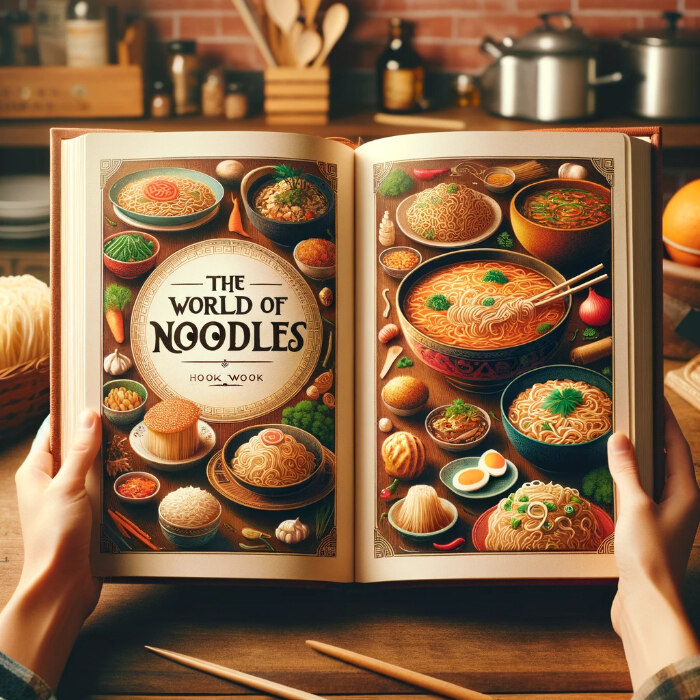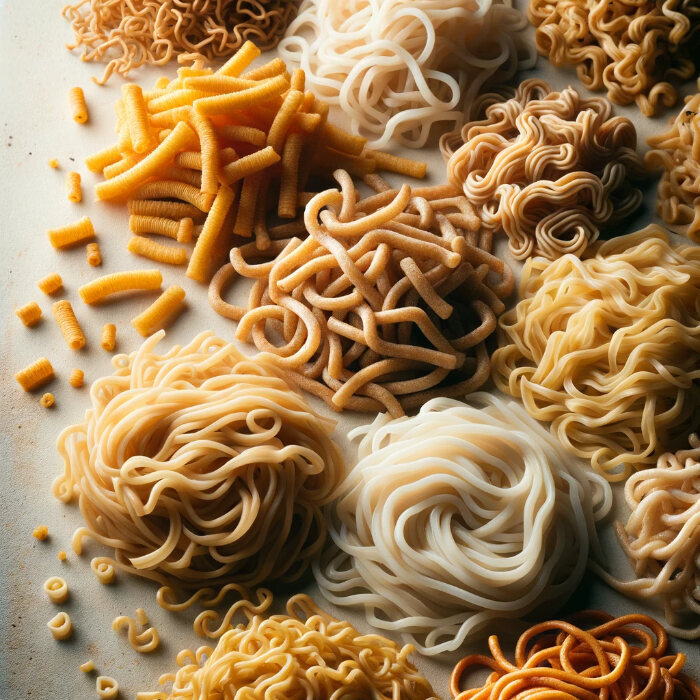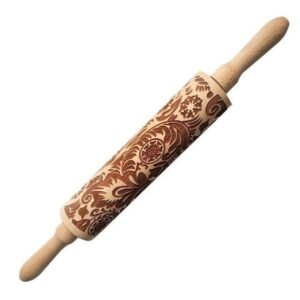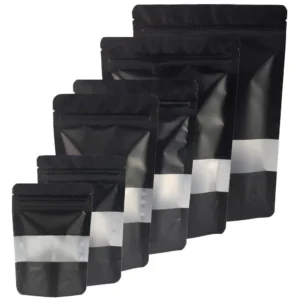Introduction
“Variety is the spice of life.” This age-old adage holds true, especially. Among the plethora of delicious dishes, chow mein and lo mein stand out as popular choices for noodle lovers. But what sets them apart? From the cooking techniques to the texture of the noodles, we’ll explore every aspect that makes these dishes unique. So if you’ve ever found yourself torn between ordering chow mein or lo mein, look no further! Join us on this culinary journey as we settle the debate once and for all.

History and Origins of Chow Mein and Lo Mein
Chow mein and lo mein are two popular Chinese noodle dishes that have been enjoyed for centuries. While they may seem similar, they actually have distinct histories and origins.
Chow Mein Originated in Northern China
Chow mein, which translates to “stir-fried noodles,” originated in Northern China and typically includes rice, tamari, and starch in the dough. It was traditionally made with wheat flour dough noodles that were stir-fried with a variety of vegetables, meat, and starch sauce. The dish was known for its crispy texture, as the noodles were fried until golden brown using starch and flour.

Lo Mein Has Its Roots in Southern China
On the other hand, lo mein has its roots in Southern China. The term “lo mein” means “tossed noodles,” referring to the method of mixing boiled noodles with various ingredients such as vegetables, meat, and sauce. Unlike chow mein, lo mein is typically not stir-fried but rather cooked in a sauce until the flavors meld together.
Both dishes have evolved over time and have become popular not only in China but also around the world. They have been adapted to suit different regional tastes and preferences.
Difference between Chow Mein and Lo Mein

Chow mein and lo mein are both popular Chinese noodle dishes, but they have some key differences that set them apart. Let’s take a closer look at the main difference between chow mein and lo mein.
Chow Mein is Stir-Fried, while Lo Mein is Boiled or Steamed
The main difference between chow mein and lo mein lies in their cooking methods. Chow mein is stir-fried, which means the noodles are cooked quickly over high heat with a variety of vegetables, meats, and sauces. On the other hand, lo mein is boiled or steamed before being tossed with the toppings and sauce.
Chow Mein Uses Crispy Noodles, while Lo Mein Uses Soft Noodles
Another noticeable difference between chow mein and lo mein is the type of noodles used. Chow mein typically uses crispy noodles that are fried until they become crunchy. These noodles add a delightful texture to the dish. In contrast, lo mein uses soft noodles that are boiled or steamed until they are tender.
The Toppings and Sauce Differ Between the Two Dishes
In addition to the cooking method and noodle texture, chow mein and lo mein also differ in terms of toppings and sauce. Chow mein often includes a variety of stir-fried vegetables such as carrots, cabbage, bean sprouts, onions, and sometimes meat like chicken or beef. It is then tossed in a savory sauce that complements the flavors of the ingredients.
On the other hand, lo mein features a simpler combination of vegetables along with proteins like shrimp or tofu if desired. The sauce for lo mein tends to be lighter compared to chow mein’s sauce.
Chow Mein vs Lo Mein: Recipes and Comparisons
Classic Chow Mein Recipe with Vegetables and Meat Options
If you’re craving a delicious stir-fried noodle dish, chow mein is the way to go. This classic recipe typically features thin egg noodles that are stir-fried with a variety of vegetables and protein options. You can choose from mouthwatering meat options like chicken, beef, or shrimp, or keep it vegetarian with tofu or just veggies.
Pros:
• Offers a satisfying crunch from the crispy noodles.
• Versatile dish that allows for customization with your favorite ingredients.
• Quick and easy to prepare in just a few simple steps.
Cons:
• The crispy noodles may not be as soft and chewy as those in lo mein.
• Can sometimes become greasy if not cooked properly.
Traditional Lo Mein Recipe with Various Protein Choices
On the other hand, if you prefer a softer and more tender noodle dish, then lo mein is the perfect choice. This traditional recipe uses thicker egg noodles that are boiled before being stir-fried with an assortment of vegetables and protein choices. Just like chow mein, you have the freedom to select your preferred protein option such as chicken, beef, pork, shrimp, or even opt for a vegetarian version.
Pros:
• Noodles have a delightful chewy texture that pairs well with the saucy flavors.
• The flavors tend to blend together more harmoniously due to longer cooking time.
Cons:
• Requires more time to cook compared to chow mein due to boiling the noodles first.
• May not offer as much crunch as chow mein because of the softer noodles.
Nutritional Comparisons between the Two Dishes
Both can be relatively healthy options when prepared with lean proteins and plenty of vegetables. However, it’s important to note that the nutritional content can vary depending on the specific ingredients and cooking methods used.
Chow mein:
• The crispy noodles in chow mein tend to absorb more oil during frying, resulting in a higher fat content.
• Opting for lean protein sources and using minimal oil can help keep the dish healthier.
Lo mein:
• The softer noodles in lo mein have a higher water content, making them lower in calories and fat compared to chow mein.
• Choosing lean proteins and incorporating an abundance of vegetables can make your lo mein even more nutritious.
Cooking Methods for Chow Mein and Lo Mein

Stir-Frying Technique for Chow Mein
To cook chow mein, the stir-frying technique is employed. This method involves quickly cooking the ingredients in a hot pan or wok with a small amount of oil over high heat. The goal is to achieve a crispy texture while retaining the flavors of the vegetables, meat, and noodles.
Stir-frying requires constant stirring and tossing of the ingredients to ensure even cooking and prevent sticking. The high heat helps to sear the ingredients quickly, resulting in a slightly charred taste that adds depth to the dish.
Boiling or Steaming Method for Lo Mein
On the other hand, lo mein is cooked using a boiling or steaming method. The noodles are typically boiled until they reach an al dente texture before being added to the stir-fried vegetables and protein. Alternatively, some recipes call for steaming the noodles instead of boiling them.
Boiling or steaming allows the noodles to absorb moisture and become soft without becoming mushy. This method also helps separate the strands of noodles so they don’t clump together when mixed with other ingredients.
Different Cooking Times
Chow mein and lo mein differ not only in their cooking methods but also in their cooking times. Due to its stir-frying technique, chow mein requires less time to cook compared to lo mein.
The high heat used in stir-frying ensures that chow mein can be prepared relatively quickly, making it an excellent option for busy weeknight dinners when you’re short on time.
In contrast, lo mein takes slightly longer due to the additional step of boiling or steaming the noodles before combining them with other ingredients.
Noodle Types in Chow Mein and Lo Mein Dishes
Chow mein and lo mein are popular noodle dishes commonly found in Chinese cuisine. While both dishes feature noodles, they differ in the type of noodles used. Let’s explore the variations of noodles used in both chow mein and lo mein dishes.
Chow Mein typically uses egg noodles
Chow mein is known for its crispy texture and savory flavors. One key characteristic of chow mein is that it typically uses egg noodles. These noodles are made from wheat flour and eggs, giving them a yellowish color and a slightly chewy texture. The egg noodles used in chow mein are often fried to achieve that delightful crunchiness.
Lo Mein commonly features wheat noodles
On the other hand, lo mein is recognized for its soft and tender noodle consistency. Unlike chow mein, lo mein commonly features wheat noodles that are boiled or cooked until they become soft. These wheat noodles can be made from fresh egg noodle dough or dried wheat flour mixed with water.
Both chow mein and lo mein offer different experiences due to their distinct noodle types. The choice between these two dishes ultimately comes down to personal preference – whether you prefer the crispy texture of fried egg noodles or the softer texture of boiled wheat noodles.
Exploring the Global Spread of Chow Mein and Lo Mein
Chinese immigrants introduced chow mein to Western countries, bringing their traditional cuisine to new lands. Chow mein typically consists of stir-fried noodles, vegetables, and meat or seafood, all tossed together in a savory sauce. It gained popularity in the United States as part of American Chinese cuisine.
On the other hand, lo mein made its mark through American Chinese cuisine as well. This dish features boiled noodles that are then stir-fried with various ingredients like vegetables and protein. The noodles have a softer texture compared to chow mein.
The global fusion of these dishes has resulted in interesting variations across different cultures. In some regions, chow mein may be served with a thicker sauce that coats the noodles more heavily. In others, it may be prepared with lighter sauces or even without any sauce at all.
Similarly, lo mein has also undergone modifications in different parts of the world. Some versions incorporate local spices and flavors to create unique taste experiences. For example, in India, you might find lo mein cooked with aromatic spices like cumin and turmeric.
These variations highlight how cuisines evolve and adapt over time when they travel far from their place of origin. As people experiment with ingredients available at home or put their own spin on traditional recipes, new flavors emerge.
So next time you’re craving some delicious Asian-inspired noodles, consider trying both chow mein and lo mein to experience the diverse tastes they offer!
Making the Right Choice – Chow Mein vs Lo Mein
Factors to Consider When Choosing Between Chow Mein and Lo Mein
When deciding between Chow Mein and Lo Mein, there are several factors to consider.
Noodle Type: One of the main differences between Chow Mein and Lo Mein is the type of noodles used. Chow Mein typically uses crispy fried noodles, while Lo Mein uses soft, boiled noodles. Consider your preference for texture when choosing between the two.
Sauce: Another important factor to consider is the sauce. Chow Mein is typically stir-fried with a lighter sauce, while Lo Mein is tossed in a thicker, more savory sauce. Think about whether you prefer a lighter or heavier sauce when making your decision.
Ingredients: The ingredients used in Chow Mein and Lo Mein can vary. Chow Mein often includes a mix of stir-fried vegetables and meat, while Lo Mein typically has a larger variety of vegetables and can be made with or without meat. Consider your dietary preferences and any specific ingredients you may want in your dish.
Cooking Method: Chow Mein is traditionally cooked at a higher heat, resulting in a crispy texture, while Lo Mein is cooked at a lower heat, resulting in a softer texture. Think about whether you prefer a crispy or soft texture when choosing between the two.
Taste Preferences Influencing the Decision-Making Process
Your taste preferences play a significant role in determining whether you should opt for chow mein or lo mein. Some people enjoy the crunchiness of chow mein noodles and find it satisfyingly different from the softer texture of lo mein noodles. Others may prefer the tenderness of lo mein noodles as they soak up the flavors of the sauce and ingredients.
• Pros: If you love crispy textures, choose chow mein; if you prefer soft textures, go for lo mein.
• Cons: If you don’t enjoy crispy textures, chow mein may not be your cup of tea; if you’re not fond of soft textures, lo mein might not be your best bet.
Dietary Restrictions Impacting the Choice
Another factor to consider when deciding between chow mein and lo mein is any dietary restrictions or preferences you may have.
• Vegetarian/Vegan Options: Both chow mein and lo mein can be made with vegetarian or vegan ingredients, such as tofu, vegetables, or plant-based protein substitutes.
• Gluten-Free Options: If you follow a gluten-free diet, it’s essential to note that traditional chow mein and lo mein noodles are made from wheat flour. However, there are gluten-free alternatives available, such as rice noodles or gluten-free pasta, which can be used to make both dishes.
Conclusion
When deciding between Chow Mein and Lo Mein, remember that it all boils down to your personal preferences. If you crave a crispy texture with a delightful mix of flavors, go for Chow Mein. On the other hand, if you prefer a softer and more saucy dish that allows the flavors to meld together harmoniously, then Lo Mein is the way to go. Trust your taste buds and let them guide you on this delicious journey!
FAQs
Can I use different types of noodles in Chow Mein or Lo Mein?
Yes! While traditional Chow Mein uses crispy egg noodles and Lo Mein uses soft wheat noodles, feel free to experiment with different types of noodles based on your preference. From udon to rice noodles or even zucchini noodles (zoodles), there are endless possibilities to explore!
Are Chow Mein and Lo Mein gluten-free?
Typically, both Chow Mein and Lo Mein dishes contain wheat-based noodles which are not gluten-free. However, you can easily find gluten-free alternatives such as rice noodles or gluten-free wheat-based noodles in specialty stores or online.
Can I make vegetarian or vegan versions of Chow Mein or Lo mein?
Absolutely! Both Chow Mein and Lo mein can be easily adapted for vegetarian or vegan diets by substituting meat with tofu or adding an array of colorful vegetables like mushrooms, bell peppers, carrots, and snow peas.
Can I reheat leftover Chow mein or Lo mein?
Yes! To reheat leftover Chow Mein or Lo Mein, simply place it in a skillet or wok with a little oil and heat it over medium-high heat until warmed through. Stir occasionally to ensure even heating.
How long do Chow Mein and Lo Mein stay fresh?
Chow Mein and Lo Mein are best enjoyed immediately after cooking when the noodles are at their freshest. However, if stored properly in an airtight container in the refrigerator, they can be kept for up to 3-4 days. Just make sure to reheat them thoroughly before consuming.
Frequently Linked Pages
1. Chow Mein – Chow Mein: A Flavorful Exploration of the Classic Chinese Stir-Fried Noodles
2. Chow Mein Recipe – Chow Mein Recipe: Quick & Easy Chicken Delight!
3. Chow Mein Noodles – Chow Mein Noodles: Delicious Recipe for the Best Chicken Chow Mein!







